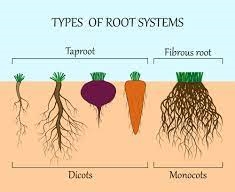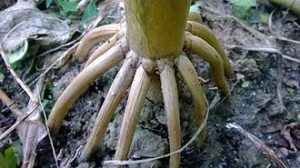Plant Root System
Root, Function & Morphology
In vascular plants, the root organ are most often below the soil surface (can also be aerial) having functions are absorption of water, plant nutrition and anchoring of the plant body to the ground.
The first root in seed producing plants is the radicle, which expands from the plant embryo after seed germination. Roots are generally Positively geotropic while negatively phototropic.
The architecture of roots ensures supply of nutrients and water as well as anchorage and support. The morphology of root is divided into four parts:
- Root cap- It helps the root penetrate the soil.
- Apical meristem- The apical meristem behind the root cap produces new root cells that elongate, Root hairs.
- the elongation zone, and
- the hair– absorb water and mineral nutrients from the soil.
Unlike stem-branches and leaves which are exogenous, i.e., they start to develop from an outer layer (cortex), roots have an endogenous origin, i.e., they originate and develop from an inner layer of the mother axis.
Roots also synthesise cytokinin, which acts as a signal as to how fast the shoots can grow. The roots of most vascular plant species enter into symbiosis with certain fungi to form mycorrhizae, and a large range of other organisms including bacteria also closely associate with roots.
Root Growth & Type
Early root growth, known as primary growth is one of the functions of the apical meristem which encompasses all elongation. A true root system consists of a primary root and secondary roots (lateral roots).
Secondary growth occurs at the lateral meristems, namely the vascular cambium and cork cambium. Secondary growth encompasses all growth in diameter.
Tap Root System
A taproot is a large, central, dominant, typically straight and very thick, tapering in shape, and grows directly downward. Other roots sprout laterally from tap root. In some plants, like in carrot, the taproot is a storage organ.
The taproot system contrasts with the adventitious- or fibrous-root system of plants with many branched roots. But many plants that grow a taproot during germination go on to develop branching root structures.
Dicots start with a taproot, which is one main root forming from the enlarging radicle of the seed. The tap root can be persistent throughout the life of the plant but is most often replaced later in the plant’s development by a fibrous root system. A persistent taproot system forms when the radicle keeps growing and smaller lateral roots form along the taproot.
The shape of taproots can vary but the typical shapes include:
- Conical root: this type of root tuber is conical in shape, i.e., widest at the top and reducing thickness towards the bottom: e.g. carrot.
- Fusiform root: this root is widest in the middle and tapers towards the top and the bottom: e.g. radish.
- Napiform root: the root has a top-like appearance. It is very broad at the top and tapers suddenly like a tail at the bottom: e.g. turnip.
Many taproots are modified into storage organs. Some plants with taproots are Beetroot, Burdock, Carrot, Sugar beet, Dandelion, Parsley, Parsnip, Poppy mallow, Radish, Sagebrush, Turnip, Common milkweed, trees such as oaks, elms, pines and firs.

Fibrous Root System
It is usually formed by thin, moderately branching roots growing from the stem. It is opposite of tap root system. A fibrous root system is universal in monocotyledonous plants and ferns. Most trees begin life with a taproot, but after one to a few years change to a wide-spreading fibrous root system with mainly horizontal surface roots and only a few vertical, deep anchoring roots. A typical mature tree 30–50 m tall has a root system that extends horizontally in all directions as far as the tree is tall or more, but well over 95% of the roots are in the top 50 cm depth of soil.
Example: All monocotyledons, Rice, wheat, maize, marigold, banana etc.
Adventitious Roots
Adventitious roots are specialized category of roots that does not develop from the radicle, instead originate from the stem, branches, leaves, or old woody roots. They commonly occur in monocots and pteridophytes, but also in many dicots, such as clover, ivy, strawberry and willow. Most aerial roots and stilt roots are adventitious. In some conifers adventitious roots can form the largest part of the root system. Distinct types of adventitious roots can be classified and are dependent on morphology, growth dynamics and function.
- Aerating roots(knee root or pneumatophores): Roots rises above the ground, especially above water such as in some mangrove genera (Avicennia, Sonneratia). In some plants like Avicennia the erect roots have a large number of breathing pores for exchange of gases.

Aerating roots of Mangroves (source:wikipedia) - Aerial roots: Roots entirely above the ground, such as in ivy (Hedera) or in epiphytic. Many aerial roots are used to receive water and nutrient intake directly from the air. Mangrove aerial roots are used for aeration and not for water absorption. Other aerial roots are used mainly for structure, functioning as prop roots (in maize) or as the trunk in strangler.

Aerial Root Epiphytes – plants living above the surface on other plants, aerial roots serve for reaching to water sources or reaching the surface, and then functioning as regular surface roots.
- Canopy roots/arboreal roots: Roots that form when tree branches support mats of epiphytes and detritus, which hold water and nutrients in the canopy. They grow out into these mats, likely to utilize the available nutrients and moisture.
- Contractile roots: roots that pull bulbs or corms of monocots, such as hyacinth and lily, and some taproots, such as dandelion, deeper in the soil through expanding radially and contracting longitudinally. They have a wrinkled surface.
- Haustorial roots: roots of parasitic plants that can absorb water and nutrients from another plant, such as in dodder.
- Propagative roots: roots that form adventitious buds that develop into aboveground shoots, termed suckers, which form new plants, as in cherry.
- Stilt roots: adventitious support roots, common among mangroves. They grow down from lateral branches, branching in the soil.
- Storage roots: roots modified for storage of food or water, such as carrots and beets. They include some taproots and tuberous roots.
- Structural roots: large roots that have undergone considerable secondary thickening and provide mechanical support to woody plants and trees.
- Tuberous roots: fleshy and enlarged lateral roots for food or water storage, e.g., sweet potato. A type of storage root distinct from taproot.
- Photosynthetic roots: roots that are green and photosynthesize, providing sugar to the plant. Several orchids have these.

Edible Roots
These include cassava, sweet potato, beet, carrot, rutabaga, turnip, parsnip, radish, yam and horseradish.
Spices obtained from roots include sassafras, angelica, sarsaparilla and licorice.
Frequently Asked Questions (FAQ)
What is the function of roots?
Absorption of water, plant nutrition and anchoring of the plant body to the ground.
What are the different types of root systems?
These are Taproots, Fibrous roots and Adventitious roots.
What are the primary and secondary roots?
Primary roots are the early roots in young plants that consist of taproots, basal roots, and lateral roots. Secondary roots are the lateral branches of the primary roots.
What are fibrous roots?
It is usually formed by thin, moderately branching roots growing from the stem. It is opposite of tap root system. Universal in monocotyledons.
Read also…
DIFFERENCE BETWEEN SHOOT AND STEM